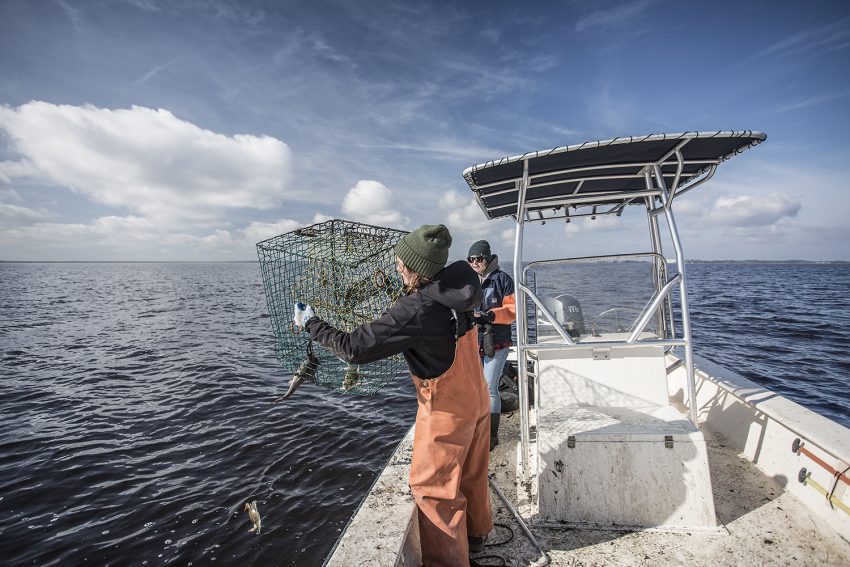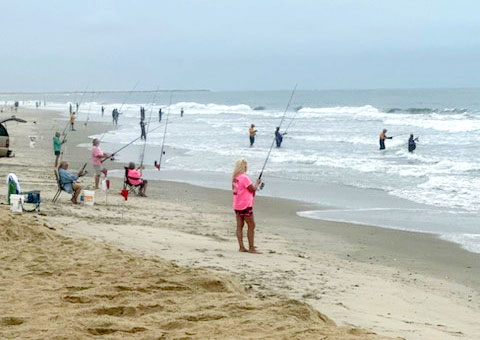Weakfish prolific spawners in North Carolina waters

The weakfish is a beautiful marine species, but is it really a “weak fish?”
According to fishers up and down the East Coast, that is the furthest thing from the truth.
Weakfish are known as strong fighters and give the most advanced fishers a challenge in hooking and landing them. The most challenging part of catching them is not to rip the hook out of their soft mouths.
They resemble and are often confused with the spotted sea trout. In North Carolina, this species is also known as either a gray trout, or just plain trout because of the similarity to the spotted sea trout, which is a completely different fish.
“Weakfish are most common along the Atlantic Coast from North Carolina to New York. The fish migrate seasonally, moving generally south and more offshore in the fall and winter months, and inshore and north in the spring and summertime,” said Tracey Bauer, North Carolina Division of Marine Fisheries weakfish biologist.
Weakfish have a dark olive-green coloration on top and are silvery on the bottom half of their bodies. Their backs and sides may have purple, lavender, green, blue, golden or copper colors mixed in. The sides are reflective with dark blotches that look like wavy lines running down the side of the fish, but not into the fins, which are yellow. They have two large canine-like teeth in the upper jaw.
“The spotted pattern is how you tell the weakfish apart from the spotted sea trout because the spots do not appear on the tail or second dorsal fins,” said Bauer.
The weakfish can grow to be 36 inches in length, but most specimens range between 12 and 16 inches long.
This species is an omnivore that has adapted to whatever food is available throughout its range. They will eat other smaller fish, crabs, shrimp, butterfish, small clams and herring.
Weakfish are considered adults when they are a year old. In northern reaches, females mature at 10 inches in length and males just slightly smaller at 9.9 inches long. Weakfish in North Carolina waters tend to reproduce when females reach 6.9 inches in length and males reach 6.5 inches.
“Weakfish spawn in the estuarine and nearshore reaches of the coast after they migrate inshore during the spring. Weakfish in North Carolina spawn over a longer period of time and begin spawning earlier than areas to the north,” Bauer said.
Spawning season runs from March to September, with peak activity from April to June. By comparison, in New York Bight, which includes the Delaware Bay through New York, the season runs from May to mid-July.
Weakfish are described as batch spawners, meaning they spawn multiple times over a single spawning season. Weakfish have been estimated to spawn anywhere between once every two days to once every 22 days, for a total of anywhere between four and 66 spawns per season. These multiple spawns mean weakfish have been estimated to release up to 11.8 million eggs per year, though the number can be as low as only 740,000.
Younger weakfish spawn less frequently than older weakfish.
Weakfish larvae range from 1/16 to 1/14 inch in length when they hatch. This species larvae have been collected in nearshore waters to offshore in coastal studies.
Weakfish prefer to use estuaries as their nursery grounds. Sampling of North Carolina sounds showed that juvenile weakfish were at their highest numbers in areas the North Carolina Division of Marine Fisheries has designated as a secondary nursery habitat regions, such as shallow bays or navigation channels characterized by moderate depths, moderately high salinities with sand or sand-grass bottoms, rather than the main nursery areas made up of shallow tributaries with low salinity and mud or mud-grass habitat. In the Chesapeake and Delaware bays, juvenile weakfish usually move from high- to low-salinity areas during summer and return to high-salinity waters in the fall and leave the estuaries typically by December.
Young weakfish can be found along the Atlantic Coast from Long Island to North Carolina at depths of 29.5 to 85 feet, usually during the late summer and fall. Researchers discovered that weakfish younger than a year old were caught in ocean trawl surveys along the coast of North Carolina at depths of 29.5-59 feet during the fall and winter, and from North Carolina to Florida at depths of 29.5-36 feet during the winter and early spring, Bauer said.
Adult weakfish seasonally migrate between offshore and inshore waters. The warming of coastal waters in spring usually triggers an inshore and northerly migration route of adult fish from their wintering grounds to estuaries, sounds, and bays. Larger fish tend to be the first to move and congregate in the northern part of their range.
Catch records from the pound net and haul seine fisheries in Pamlico Sound, Chesapeake Bay and Delaware Bay tell researchers that larger fish are then followed by a second group of smaller fish during summer. Just after they arrive, weakfish return to the larger bays and maybe to the ocean to spawn. In northern areas, large numbers of adults spend the summer in ocean waters instead of in estuaries.
As water temperatures drop during the fall, weakfish form into schools and move offshore and typically south along the coast. It appears that the continental shelf from Chesapeake Bay to Cape Lookout is the primary wintering ground for weakfish.
“The growth rate of weakfish is very fast during their first year,” said Bauer.
In Delaware Bay, juveniles may grow from 0.83 to 1.18 inches per month from June to September and can grow to lengths between 3.94 to 6.9 inches in length throughout the range by the end of their first year.
“The size of the young fish will be determined by where they have been collected and the food and available to eat,” she said.
Movements of weakfish show geographic variations in growth, with their size increasing the farther north they are collected along the Atlantic Coast.
Northern weakfish collected between Cape Cod and Ocean City, Maryland, were largest, while those caught Virginia Beach and Cape Fear were smaller. The size of fish caught between Chesapeake Bay to Virginia Beach were intermediate and were similar to Delaware Bay. Growth of weakfish of southern half of their range may also be limited by food availability or by their DNA makeup, she concluded.
“Weakfish have been one of the most important components of a mixed-stock commercial fishery on the Atlantic coast since the 1800s. with several periods of high and low landings. Commercial landings peaked in 1980 at about 36 million pounds coast wide and a little over 20 million pounds in North Carolina. Commercial landings remained relatively high through the 1980s and generally declined since then,” said Chris Batsavage, special assistant for councils and the North Carolina Division of Marine Fisheries representative on the Atlantic States Marine Fisheries Commission.
In 2020, coastwide and North Carolina commercial weakfish landings were 232,684 pounds and 87,784 pounds, respectively. Batsavage noted that commercial weakfish landings since 2010 had been limited by the commercial trip and bycatch limits of no greater than 100 pounds that are required by the Atlantic States Marine Fisheries Commission’s Weakfish Fishery Management Plan.
“Weakfish have historically been landed in haul seines, pound nets, trawls and gill nets, with gill nets the predominant gear since the 1990s. North Carolina, Virginia and New York account for the majority of the commercial landings. Discarding of weakfish by commercial fishermen is known to occur, and the discard mortality is assumed to be 100%,” Batsavage added.
Recreational weakfish harvest has shown a similar trend as commercial landings with a peak in the early to mid-1980s and a marked decline since the early 2000s. In 2020, the coastwide recreational harvest was 481,418 pounds with 105,729 pounds landed in North Carolina. Since 2010, the Atlantic States Marine Fisheries Commission’s Weakfish Fishery Management Plan required a one-fish bag limit and a minimum size limit of at least 12 inches total length, which has contributed to the low harvest over the last decade or so.
North Carolina, South Carolina and New York account for the majority of the recreational harvest. Virginia hasn’t been among the top states for recreational harvest in recent years.
It is assumed that 10% of weakfish released alive by recreational anglers die. Although the total number of weakfish released follows a similar trend as recreational harvest, the proportion of weakfish released has increased since 2010, Batsavage said.
A 2019 stock assessment update shows weakfish still showed signs of being depleted as they have been since 2003. The fish stock is considered depleted when it is below the spawning stock biomass, or SSB, threshold of 30% or 13.6 million pounds. In 2017, the SSB was only 4.24 million pounds. While the assessment shows some good signs in the weakfish population recently, with a slight increase in SSB and total abundance, the stock is still well below the self-sustainable threshold.
“The assessment also shows natural mortality, or the rate at which fish die because of natural causes such as starvation, disease, predation, has been going up since the early 2000s. The assessment therefore uses total mortality, which includes fishing mortality and natural mortality, as benchmarks to prevent an increase in fishing pressure during times of high natural mortality and low fishing mortality. Although total mortality has decreased since 2010, it is still too high for the stock to recover,” Batsavage said.
North Carolina gives awards for the catch and keep of a weakfish that is 5 pounds and larger. They also give out awards for the live release of a weakfish measuring 24 inches or longer. A total of 10 weight citations and three release citations were issued for weakfish in 2020, the most recent totals available.
Anglers catch weakfish with natural or artificial baits by a variety of techniques including bottom fishing and jigging. They commonly use sting silvers and spec rigs. The weakfish have soft mouths. Anglers should keep the line tight, yet not pull too hard because the hook could rip through the lip and permanently injure the fish.







